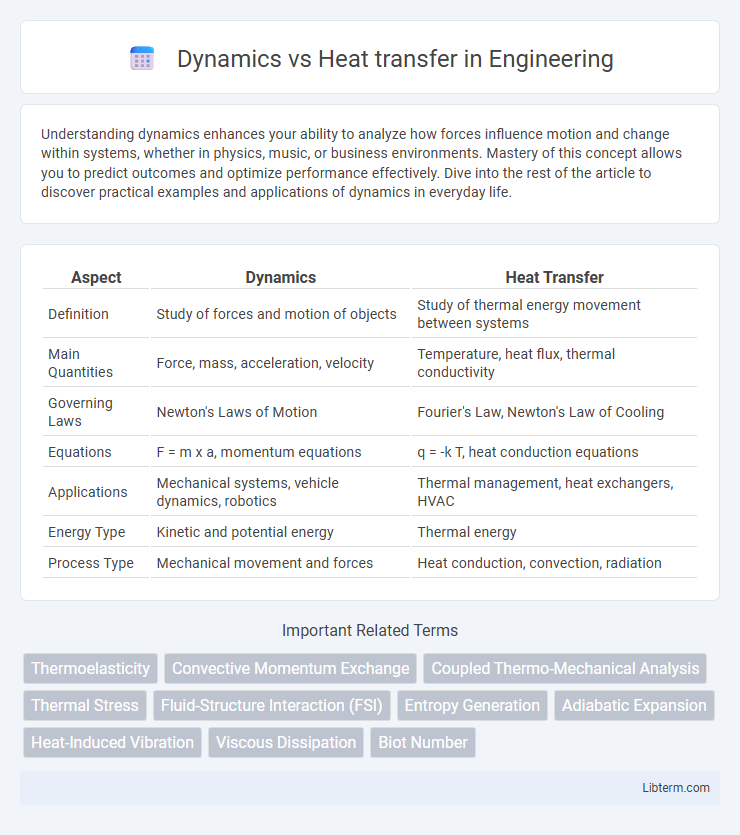Understanding dynamics enhances your ability to analyze how forces influence motion and change within systems, whether in physics, music, or business environments. Mastery of this concept allows you to predict outcomes and optimize performance effectively. Dive into the rest of the article to discover practical examples and applications of dynamics in everyday life.
Table of Comparison
| Aspect | Dynamics | Heat Transfer |
|---|---|---|
| Definition | Study of forces and motion of objects | Study of thermal energy movement between systems |
| Main Quantities | Force, mass, acceleration, velocity | Temperature, heat flux, thermal conductivity |
| Governing Laws | Newton's Laws of Motion | Fourier's Law, Newton's Law of Cooling |
| Equations | F = m x a, momentum equations | q = -k T, heat conduction equations |
| Applications | Mechanical systems, vehicle dynamics, robotics | Thermal management, heat exchangers, HVAC |
| Energy Type | Kinetic and potential energy | Thermal energy |
| Process Type | Mechanical movement and forces | Heat conduction, convection, radiation |
Introduction to Dynamics and Heat Transfer
Dynamics studies the forces and motion of objects, analyzing velocity, acceleration, and the resulting changes in physical systems. Heat transfer examines energy transfer due to temperature differences through conduction, convection, and radiation. Both fields are fundamental to engineering, with dynamics focusing on mechanical systems and heat transfer addressing thermal energy management.
Fundamental Concepts: Dynamics Explained
Dynamics involves the study of forces and motion, focusing on how objects move and interact under various forces. Heat transfer, on the other hand, deals with the movement of thermal energy between systems through conduction, convection, and radiation. Understanding dynamics provides insight into the forces causing motion, which can influence energy distribution and temperature changes within physical systems.
Key Principles of Heat Transfer
Heat transfer involves three key principles: conduction, convection, and radiation, describing the modes by which thermal energy moves between bodies or within materials. Conduction transfers heat through direct molecular collision in solids, convection involves fluid motion carrying heat, and radiation emits electromagnetic waves transporting energy without needing a medium. Understanding these mechanisms is essential for analyzing thermal dynamics in engineering systems and natural processes.
Interrelation Between Dynamics and Heat Transfer
The interrelation between fluid dynamics and heat transfer is fundamental in optimizing thermal systems, where fluid flow behavior directly influences convective heat transfer rates. Turbulence intensity, boundary layer development, and velocity profiles determine the efficiency of heat exchange processes in applications like cooling systems and heat exchangers. Understanding this dynamic interplay enables precise control over temperature distribution and energy efficiency in industrial and environmental settings.
Governing Equations in Dynamics
The governing equations in dynamics primarily include Newton's Second Law expressed through the Navier-Stokes equations for fluid dynamics, which describe the motion and forces in fluid flow. These partial differential equations account for momentum conservation, incorporating factors such as pressure, viscosity, and external body forces. Unlike heat transfer equations, which focus on energy conservation and temperature distribution, dynamics emphasizes velocity fields and fluid acceleration in complex systems.
Governing Equations in Heat Transfer
Governing equations in heat transfer primarily include the heat conduction equation, known as Fourier's law, which relates the heat flux to the temperature gradient within a material. The transient heat conduction equation, or the heat diffusion equation, describes temperature variation over time and space, incorporating thermal conductivity, density, and specific heat capacity. Unlike fluid dynamics governed by Navier-Stokes equations, heat transfer equations focus on thermal energy conservation and transport mechanisms such as conduction, convection, and radiation.
Real-World Applications: Dynamics vs Heat Transfer
Dynamics governs the motion and forces acting on objects, critical in automotive crash analysis and aerospace trajectory planning, ensuring safety and performance optimization. Heat transfer principles drive the design of efficient cooling systems in electronics and HVAC units, maintaining operational temperatures and energy efficiency. Understanding both dynamics and heat transfer enables engineers to develop integrated solutions for thermal management in moving mechanical systems, such as turbine engines and electric vehicle batteries.
Challenges in Modeling Dynamics and Heat Transfer
Modeling dynamics and heat transfer involves complex challenges such as accurately capturing transient behaviors and nonlinear interactions between thermal and mechanical systems. Precise simulation requires integrating multifaceted equations governing fluid flow, heat conduction, and convection while addressing scale disparities and material property variations. Computational cost and stability issues further complicate the development of predictive and reliable dynamic heat transfer models.
Advanced Analysis Techniques
Advanced analysis techniques in dynamics utilize finite element methods and modal analysis to predict system behavior under varying loads and conditions, providing detailed insights into vibrations and structural responses. Heat transfer analysis employs computational fluid dynamics (CFD) and conjugate heat transfer (CHT) simulations to model conduction, convection, and radiation phenomena with high accuracy in complex geometries. Combining these techniques enables integrated thermo-mechanical simulations essential for optimizing performance and durability in aerospace, automotive, and electronics engineering.
Future Trends in Dynamics and Heat Transfer
Future trends in dynamics emphasize the integration of artificial intelligence and machine learning algorithms to optimize system performance and predict complex fluid behaviors with greater accuracy. In heat transfer, advancements focus on nanoscale thermal management techniques and the development of metamaterials with enhanced thermal conductivity, enabling more efficient energy systems. Both fields converge on smart sensors and real-time data analytics to drive innovations in energy efficiency and environmental sustainability.
Dynamics Infographic

 libterm.com
libterm.com